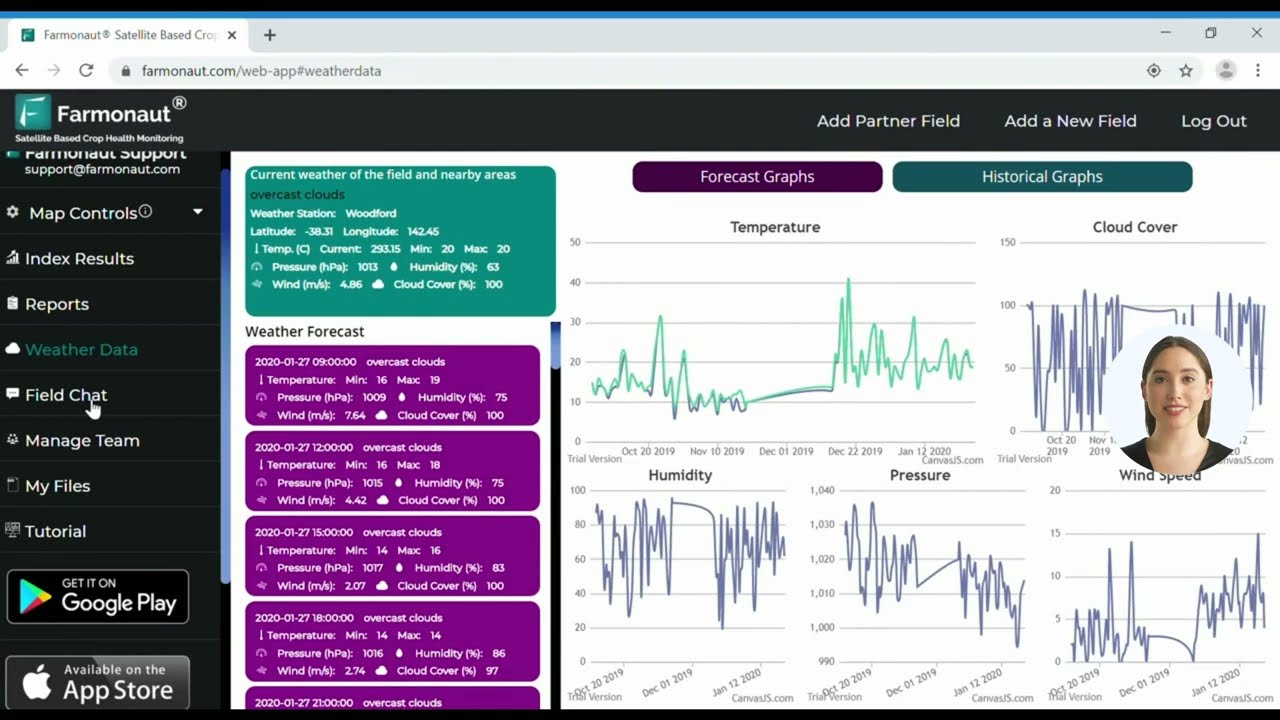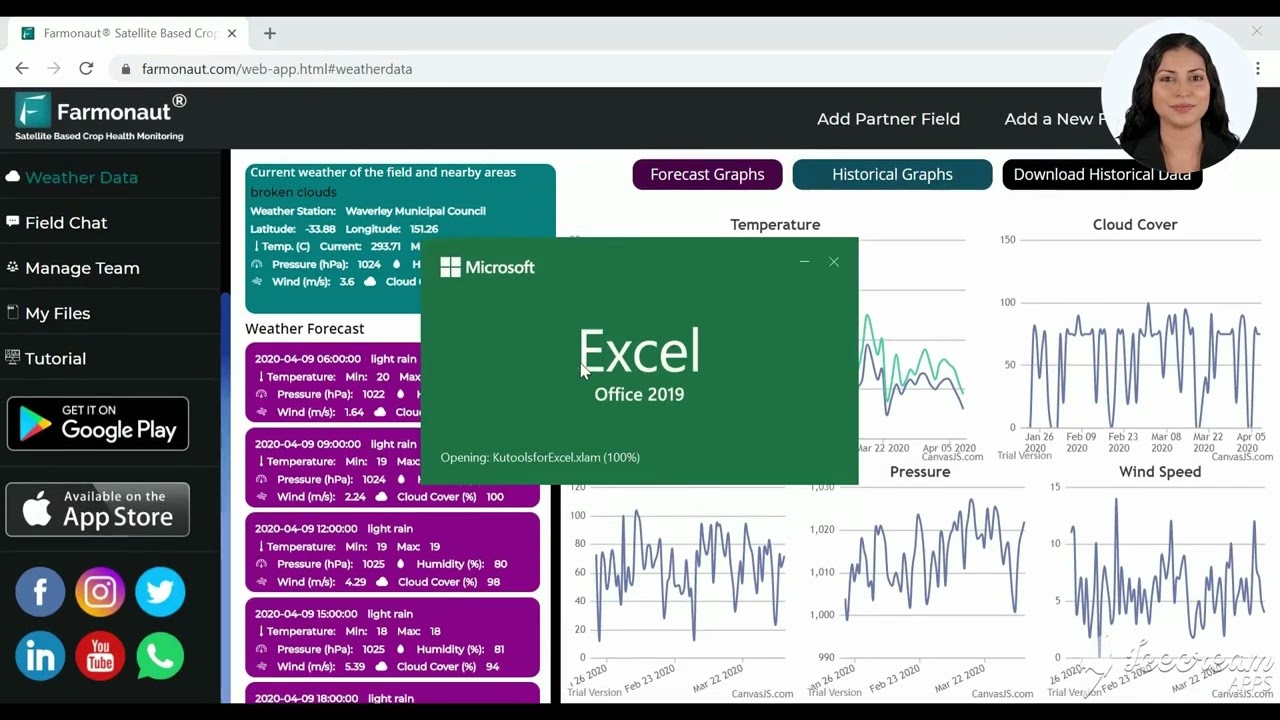USDA Declares 17 Maryland Counties Natural Disaster Areas: Emergency Farm Loans Available for Drought Recovery
“17 Maryland counties designated as Natural Disaster Areas, with emergency farm loans now available for drought recovery.”
As representatives of Farmonaut, we’re deeply concerned about the recent drought conditions affecting farmers across Maryland and neighboring states. The U.S. Department of Agriculture’s (USDA) recent declaration of 17 Maryland counties as Natural Disaster Areas highlights the severity of the situation and the urgent need for support in the agricultural community. In this comprehensive blog post, we’ll explore the details of this declaration, its implications for farmers, and the various forms of assistance available to those affected by the drought.
Understanding the USDA’s Natural Disaster Area Declaration
The USDA’s decision to designate 17 Maryland counties as Natural Disaster Areas comes in response to the severe drought conditions that have plagued the region during the critical growing season. This declaration is a significant step towards providing much-needed relief to farmers and agricultural businesses struggling with the impacts of prolonged dry conditions.
Drought Intensity Classifications
The U.S. Drought Monitor, a key tool in assessing drought conditions, uses a scale to classify drought intensity:
- D2: Severe Drought
- D3: Extreme Drought
- D4: Exceptional Drought
Counties experiencing D2 drought conditions for eight or more consecutive weeks, or those facing D3 or D4 conditions, are eligible for this disaster designation. This classification system helps prioritize areas in most urgent need of assistance.

Eligible Counties and Contiguous Areas
The USDA’s declaration extends beyond Maryland’s borders, recognizing that drought doesn’t adhere to state lines. Here’s a breakdown of the affected areas:
Maryland Counties (Primary):
- Allegany
- Anne Arundel
- Baltimore
- Calvert
- Caroline
- Cecil
- Charles
- Dorchester
- Garrett
- Kent
- Prince George’s
- Queen Anne’s
- St. Mary’s
- Somerset
- Talbot
- Wicomico
- Worcester
Contiguous Counties in Neighboring States:
- Delaware: Kent, New Castle, Sussex
- District of Columbia
- Pennsylvania: Bedford, Chester, Fayette, Fulton, Lancaster, Somerset, York
- Virginia: Accomack, Fairfax, King George, Prince William, Stafford, Westmoreland, Alexandria
- West Virginia: Grant, Hampshire, Mineral, Morgan, Preston
This extensive list underscores the widespread nature of the drought and its impact on the agricultural sector across multiple states.
Emergency Farm Loans: A Lifeline for Struggling Farmers
The USDA Farm Service Agency (FSA) is now empowered to extend emergency credit to producers in these designated areas. These natural disaster loans for farmers serve as a crucial lifeline, offering financial support when it’s needed most.
Key Features of Emergency Agricultural Loans:
- Replacement of essential equipment or livestock
- Reorganization of farming operations
- Refinancing of certain debts
The FSA will carefully review each loan application, considering factors such as:
- Extent of losses
- Available security
- Repayment ability
These emergency agricultural loans are designed to be flexible, acknowledging the diverse needs of farmers facing drought-related challenges.
Drought Assistance Programs: Beyond Emergency Loans
While emergency loans are a critical component of the USDA’s response, they’re not the only form of support available. The USDA offers a range of drought assistance for farmers programs designed to address various aspects of agricultural recovery:
- Disaster Set-Aside Program: Allows borrowers with existing FSA loans to move a payment to the end of the loan term if they’re unable to make the payment due to the disaster.
- Emergency Conservation Program: Provides funding to rehabilitate farmland damaged by natural disasters.
- Livestock Forage Disaster Program: Offers compensation to eligible livestock producers who have suffered grazing losses due to drought or fire.
- Emergency Assistance for Livestock, Honeybees, and Farm-Raised Fish Program: Provides emergency relief for losses due to disease, adverse weather, or other conditions not covered by other disaster programs.
These programs, part of the broader suite of USDA disaster relief programs, are designed to provide comprehensive support for various aspects of farm operations affected by drought conditions.
Navigating the Application Process
For farmers seeking to access these vital resources, the application process is a critical step. Here’s a guide to help navigate the process:
- Contact Your Local USDA Service Center: This should be your first step. Local representatives can provide personalized guidance on available programs and eligibility requirements.
- Gather Documentation: Be prepared to provide evidence of drought-related losses, financial records, and other relevant documentation.
- Explore Online Resources: The USDA offers several online tools to help farmers identify suitable programs:
- Disaster Assistance Discovery Tool
- Loan Assistance Tool
- Submit Your Application: Work with FSA representatives to complete and submit your application for emergency loans or other assistance programs.
- Follow Up: Stay in touch with your local USDA Service Center throughout the process for updates and additional guidance.
Remember, timely action is crucial when applying for farm disaster recovery resources. Many programs have specific deadlines, so early engagement with the USDA is highly recommended.
“USDA’s disaster relief covers regions experiencing D2, D3, or D4 drought intensity across 5 states during the growing season.”
The Role of Technology in Drought Mitigation and Farm Management
While emergency assistance is crucial for immediate relief, long-term resilience in the face of drought requires innovative approaches to farm management. This is where agricultural technology plays a vital role.
At Farmonaut, we’re committed to providing farmers with cutting-edge tools to monitor and manage their crops effectively, even in challenging conditions. Our satellite-based crop health monitoring system offers real-time insights into vegetation health, soil moisture levels, and other critical metrics. This data can be invaluable for making informed decisions about irrigation, fertilizer usage, and pest management, helping to optimize crop yields and reduce resource wastage.
For farmers dealing with drought conditions, our crop plantation and forest advisory services can provide tailored recommendations to mitigate the impacts of water scarcity. By leveraging AI and satellite data, we offer personalized strategies for crop selection, planting times, and resource allocation that can help farms remain productive even in dry conditions.

Financial Implications and Support for Agricultural Businesses
The drought’s impact extends beyond individual farms to affect entire agricultural businesses. Understanding and addressing these broader financial implications is crucial for the sector’s recovery.
Agricultural Emergency Credit
In addition to the USDA’s emergency loans, various financial institutions may offer specialized agricultural emergency credit options. These can provide much-needed liquidity for businesses facing drought-related challenges. It’s worth exploring options with local banks and credit unions that have experience in agricultural lending.
Crop Insurance and Risk Management
For many farmers, crop insurance serves as a critical safety net in times of natural disasters. The current situation underscores the importance of robust risk management strategies. Farmers should review their existing insurance coverage and consider adjustments to better protect against future drought risks.
Farmonaut’s crop loan and insurance verification services can play a crucial role here. By providing accurate, satellite-based data on crop health and yields, we help streamline the process of loan approvals and insurance claims, ensuring farmers can access financial support more quickly and efficiently.
Long-Term Strategies for Drought Resilience
While immediate relief is crucial, building long-term resilience to drought conditions is equally important. Here are some strategies that farmers and agricultural businesses can consider:
- Water Conservation Techniques: Implement advanced irrigation systems, such as drip irrigation or precision sprinklers, to maximize water efficiency.
- Drought-Resistant Crop Varieties: Consider transitioning to crop varieties that are better suited to withstand dry conditions.
- Soil Health Management: Focus on practices that improve soil structure and water retention, such as cover cropping and reduced tillage.
- Diversification: Spread risk by diversifying crop types or incorporating livestock to create additional income streams.
- Technology Adoption: Leverage agricultural technology for better decision-making. Farmonaut’s satellite-based monitoring can provide crucial insights for proactive farm management.
By implementing these strategies, farmers can work towards creating more drought-resilient operations, reducing their vulnerability to future dry spells.
Community Support and Resources
In times of agricultural crisis, community support can be invaluable. Here are some ways the agricultural community can come together:
- Knowledge Sharing: Organize local workshops or online forums where farmers can share drought management strategies and experiences.
- Equipment Sharing: Consider establishing equipment-sharing programs to help spread the cost of drought-mitigation technologies.
- Mental Health Support: Recognize the emotional toll of drought and provide access to mental health resources for farmers and their families.
- Local Food Initiatives: Support local farmers by promoting community-supported agriculture (CSA) programs and farmers’ markets.
These community-driven initiatives can complement government assistance programs, creating a more robust support network for affected farmers.
The Environmental Impact of Drought and Sustainable Farming Practices
Drought conditions not only affect agricultural productivity but also have broader environmental implications. As we address the immediate needs of farmers, it’s crucial to consider long-term sustainability and environmental stewardship.
Carbon Footprint Considerations
Drought can lead to changes in farming practices that may inadvertently increase a farm’s carbon footprint. For instance, increased reliance on groundwater pumping or the need for additional fertilizers can contribute to higher emissions. Farmonaut’s carbon footprinting tools can help farmers monitor and manage their environmental impact, even in challenging conditions.
Sustainable Water Management
Adopting sustainable water management practices is crucial for long-term drought resilience. This might include:
- Rainwater harvesting systems
- Precision irrigation techniques
- Drought-tolerant landscaping
By implementing these practices, farmers can reduce their vulnerability to future droughts while also contributing to broader water conservation efforts.
The Role of Policy in Drought Mitigation and Agricultural Resilience
While immediate relief measures are crucial, long-term solutions to drought challenges often require policy interventions. Here are some policy areas that can significantly impact drought resilience in agriculture:
- Water Rights and Allocation: Policies governing water rights and allocation can significantly affect farmers’ ability to access water during drought conditions. Advocating for fair and efficient water allocation systems is crucial.
- Climate-Smart Agriculture Incentives: Policies that incentivize the adoption of climate-smart agricultural practices can help build overall farm resilience to extreme weather events, including droughts.
- Research and Development Funding: Increased funding for agricultural research, particularly in drought-resistant crop varieties and water-efficient farming techniques, can drive innovation in the sector.
- Infrastructure Investment: Policies supporting investment in water infrastructure, such as modernizing irrigation systems and improving water storage facilities, can enhance the agricultural sector’s ability to withstand drought conditions.
Farmers and agricultural stakeholders should stay informed about these policy areas and engage with local representatives to advocate for supportive measures.
Leveraging Technology for Efficient Farm Management
In the face of challenges like drought, efficient farm management becomes more critical than ever. Technology can play a pivotal role in optimizing operations and resource use. Farmonaut’s suite of tools offers several solutions to enhance farm efficiency:
- Fleet Management: Our fleet management tools can help agribusinesses optimize their vehicle usage, ensuring efficient distribution of resources and reducing operational costs during challenging times.
- Large Scale Farm Management: For larger operations, our agro-admin app provides comprehensive oversight of multiple farm locations, enabling centralized decision-making based on real-time data.
- Traceability Solutions: In times of resource scarcity, ensuring efficient use of inputs is crucial. Our blockchain-based traceability solutions can help track the journey of agricultural products, optimizing supply chains and reducing waste.
By leveraging these technological solutions, farmers can make data-driven decisions that maximize efficiency and resilience in the face of drought conditions.
County-Specific Drought Assistance Overview
To provide a clear picture of the assistance available across the affected regions, we’ve compiled a comprehensive table detailing the drought intensity and loan eligibility for each county:
| County Name | State | Drought Intensity | Eligible for Emergency Loans | Estimated Loan Amount Range |
|---|---|---|---|---|
| Allegany | Maryland | D3 | Yes | $50,000 – $500,000 |
| Anne Arundel | Maryland | D2 | Yes | $25,000 – $250,000 |
| Baltimore | Maryland | D2 | Yes | $25,000 – $250,000 |
| Kent | Delaware | D2 | Yes | $25,000 – $250,000 |
| Bedford | Pennsylvania | D3 | Yes | $50,000 – $500,000 |
| Accomack | Virginia | D2 | Yes | $25,000 – $250,000 |
| Grant | West Virginia | D3 | Yes | $50,000 – $500,000 |
This table provides a snapshot of the assistance landscape across the affected regions. It’s important to note that loan amounts can vary based on individual circumstances and the specific needs of each farm or agricultural business.
Looking Ahead: Building a Drought-Resilient Agricultural Future
As we navigate the current drought crisis, it’s essential to look ahead and consider how we can build a more resilient agricultural sector. This involves a multi-faceted approach that combines technological innovation, sustainable practices, and community collaboration.
Embracing Innovation
The adoption of advanced agricultural technologies will play a crucial role in building drought resilience. Farmonaut’s satellite-based monitoring and AI-driven advisory systems represent just the beginning of what’s possible. Future innovations might include:
- Advanced weather prediction models for more accurate long-term forecasting
- AI-powered irrigation systems that can autonomously adjust water usage based on real-time soil and atmospheric conditions
- Drought-resistant crop varieties developed through genetic engineering and selective breeding
Sustainable Water Management
Moving forward, sustainable water management will be critical. This might involve:
- Large-scale implementation of water-efficient irrigation techniques
- Development of drought-resistant farming systems that can thrive with minimal water input
- Increased focus on water recycling and reuse in agricultural operations
Community and Policy Engagement
Building a drought-resilient future will require active engagement from all stakeholders:
- Farmers collaborating to share best practices and resources
- Policymakers working with agricultural experts to develop supportive legislation
- Consumers supporting sustainable farming practices through their purchasing decisions
By working together and leveraging the best available technologies and practices, we can create an agricultural sector that is not just resistant to drought, but thrives in the face of environmental challenges.
Conclusion: A Call to Action
The USDA’s declaration of 17 Maryland counties as Natural Disaster Areas due to drought conditions is a stark reminder of the challenges facing our agricultural sector. However, it also represents an opportunity for farmers and agricultural businesses to access crucial support and implement more resilient practices.
We encourage all affected farmers to:
- Reach out to their local USDA Service Center to explore available assistance programs
- Consider implementing drought-resistant farming practices and technologies
- Stay informed about ongoing policy developments related to agricultural disaster relief
- Engage with community support networks and share knowledge with fellow farmers
At Farmonaut, we’re committed to supporting farmers through these challenging times with our advanced agricultural technology solutions. By combining immediate relief measures with long-term resilience strategies, we can work towards a more sustainable and drought-resistant agricultural future.
Remember, in times of crisis, knowledge and community support are powerful tools. Let’s work together to overcome these challenges and build a stronger, more resilient agricultural sector.
Frequently Asked Questions (FAQ)
- Q: Who is eligible for the USDA’s emergency farm loans?
A: Farmers and agricultural businesses in the 17 designated Maryland counties and contiguous areas in Delaware, Pennsylvania, Virginia, and West Virginia are eligible for these loans. - Q: What can emergency farm loans be used for?
A: These loans can be used to replace essential equipment or livestock, reorganize farming operations, or refinance certain debts. - Q: How long do farmers have to apply for emergency assistance?
A: While specific deadlines can vary by program, it’s advisable to contact your local USDA Service Center as soon as possible to explore your options. - Q: Are there any drought assistance programs available besides emergency loans?
A: Yes, the USDA offers several other programs such as the Disaster Set-Aside Program, Emergency Conservation Program, and Livestock Forage Disaster Program. - Q: How can technology help in managing drought conditions?
A: Technologies like Farmonaut’s satellite-based crop monitoring can provide real-time insights into crop health and soil moisture, helping farmers make informed decisions about resource allocation.
Earn With Farmonaut: Affiliate Program
Earn 20% recurring commission with Farmonaut’s affiliate program by sharing your promo code and helping farmers save 10%. Onboard 10 Elite farmers monthly to earn a minimum of $148,000 annually—start now and grow your income!
Farmonaut Subscriptions
For more information on our services and how we can help you navigate these challenging times, please explore our platform:
For developers interested in integrating our technology into their own solutions, check out our API and API Developer Docs.




















